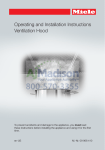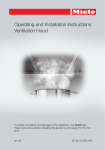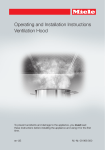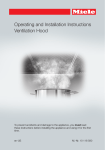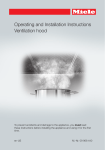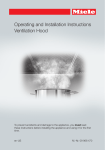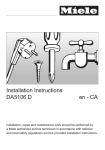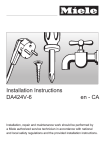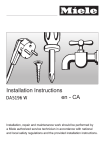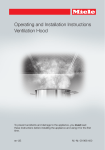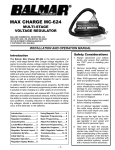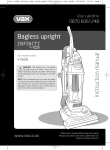Download Miele Ventilation Hood Technical data
Transcript
Operating and Installation Instructions Ventilation Hood To prevent accidents and damage to the appliance, you must read these instructions before installing the appliance and using it for the first time. en-US M.-Nr. 09 805 980 Contents IMPORTANT SAFETY INSTRUCTIONS................................................................. 4 Caring for the environment ................................................................................. 13 Description of functions ...................................................................................... 14 Con@ctivity 2.0 function ........................................................................................ 15 Guide to the appliance......................................................................................... 16 Operation (Automatic mode)............................................................................... 18 Cooking with Con@ctivity 2.0 (Automatic mode)................................................... 18 Temporarily exiting Automatic mode ..................................................................... 20 Resuming Automatic mode ................................................................................... 20 Operation (Manual mode).................................................................................... 21 Cooking without Con@ctivity 2.0 (Manual mode) .................................................. 21 Turning on the fan .................................................................................................. 21 Selecting the power level....................................................................................... 21 Selecting the delayed shut down time................................................................... 21 Turning off the fan .................................................................................................. 21 Turning overhead lighting on/off ............................................................................ 22 Power management ............................................................................................... 22 Operation (Automatic and Manual modes)........................................................ 23 Filter saturation indicator ....................................................................................... 23 Adjusting the filter saturation indicator for the grease filter .............................. 23 Activating/changing the OdorFree Charcoal Filter operating hours counter .... 24 Checking the filter saturation indicator ............................................................. 24 Sensor button signal tone ...................................................................................... 25 Cleaning and care ................................................................................................ 26 Stainless steel housing .......................................................................................... 26 Special instructions for glass surfaces ............................................................. 27 Grease filters .......................................................................................................... 27 OdorFree Charcoal Filter........................................................................................ 29 Resetting the operating hours counter for the OdorFree Charcoal Filter.......... 30 Disposing of the OdorFree Charcoal Filter........................................................ 30 Installation ............................................................................................................ 31 Before installation .................................................................................................. 31 Installation parts..................................................................................................... 31 Appliance dimensions............................................................................................ 32 Distance between cooktop and ventilation hood (S) ............................................. 33 Installation recommendations................................................................................ 34 Structural support .................................................................................................. 34 2 Contents Removing the protective film ................................................................................. 34 Exhaust duct......................................................................................................... 46 Condensate trap .................................................................................................... 47 Electrical connection ........................................................................................... 48 Grounding Instructions .......................................................................................... 48 Activating Con@ctivity 2.0 ................................................................................... 49 Installation of the Con@ctivity 2.0 stick ................................................................. 49 Activating the Con@ctivity 2.0 function ................................................................. 49 Activating the ventilation hood ......................................................................... 49 Activating the cooktop...................................................................................... 50 Activation failed ................................................................................................ 50 Deactivating Con@ctivity 2.0 ................................................................................. 50 Service and warranty ........................................................................................... 51 Location of the data plate ...................................................................................... 51 Technical data ..................................................................................................... 52 3 IMPORTANT SAFETY INSTRUCTIONS READ AND SAVE THESE INSTRUCTIONS This appliance complies with current safety requirements. Improp‐ er use of the appliance can lead to personal injury and material damage. Read all instructions before installing or using the appliance for the first time. Only use the appliance for its intended purpose. Keep these operating instructions in a safe place and pass them on to any future user. Use CAUTION: For General Ventilating Use Only. Do Not Use To Ex‐ haust Hazardous Or Explosive Materials And Vapors. This appliance is intended for residential use only. Use only as de‐ scribed in these operating instructions. This ventilation hood is designed for domestic use and for use in similar residential environments. This ventilation hood is not intended for outdoor use. It must only be used to extract and clean vapors produced during cooking. Any other use occurs at the owner's own risk. This appliance is suitable for installation above gas or electric cooking surfaces. Persons who lack physical, sensory or mental abilities, or experi‐ ence with the appliance should not use it without supervision or in‐ struction by a responsible person. 4 IMPORTANT SAFETY INSTRUCTIONS Children As with any appliance, close supervision is necessary when used by children. Please supervise children in the vicinity of the hood and do not let them play with it. Danger of suffocation! Ensure that any plastic wrappings, bags, etc. are disposed of safely and kept out of the reach of children. Technical safety WARNING: TO REDUCE THE RISK OF FIRE, ELECTRIC SHOCK, OR INJURY TO PERSONS, OBSERVE THE FOLLOWING: – Use this appliance only in the manner intended by the manufac‐ turer. If you have questions, contact Miele. – Before servicing or cleaning the appliance, switch power off at the service panel and lock the service disconnecting means to prevent power from being switched on accidentally. If the service disconnecting means cannot be locked, securely fasten a promi‐ nent warning device, such as a tag, to the service panel. Installation, repair and maintenance work should be performed by a Miele authorized service technician in accordance with national and local safety regulations and the provided installation instruc‐ tions. Contact Miele’s Technical Service Department for examina‐ tion, repair or adjustment. Repairs and other work by unauthorized persons could be dangerous and may void the warranty. A damaged ventilation hood oven can be dangerous. Always check for visible signs of damage. Never use a damaged ventilation hood. 5 IMPORTANT SAFETY INSTRUCTIONS Be certain your appliance is properly installed and grounded by a qualified technician. To guarantee the electrical safety of this appli‐ ance, continuity must exist between the appliance and an effective grounding system. It is imperative that this basic safety requirement be met. If there is any doubt, have the electrical system of the house checked by a qualified electrician. To avoid damaging the ventilation hood, make sure that the con‐ nection data (voltage and frequency) on the data plate correspond to the building's power supply before connecting the appliance. When in doubt, consult a qualified electrician. Do not use a power bar or extension cord to connect the ventila‐ tion hood to electricity. These are a fire hazard and do not guarantee the required level of appliance safety. To ensure safe operation, only use the ventilation hood after it has been properly installed. This ventilation hood may not be used in non-stationary locations (e.g. on a ship). Only open the housing as described in the enclosed "Installation diagram" and in the "Cleaning and care" section of this manual. Un‐ der no circumstances should any other parts of the housing be opened. Tampering with electrical connections or components and mechani‐ cal parts is highly dangerous to the user and can cause operation faults. 6 IMPORTANT SAFETY INSTRUCTIONS Defective components should be replaced by Miele original parts only. Only with these parts can the manufacturer guarantee the safe‐ ty of the appliance. During installation, maintenance, and repair work, the ventilation hood must be disconnected from the electrical supply. It is only completely isolated from the electricity supply if one of the following applies: – The circuit breakers on the electrical service panel are tripped. – The screw-type fuses on the electrical service panel have been removed. – The power cable (if present) has been unplugged from the socket (pull the plug not the cord). Proper use WARNING: TO REDUCE THE RISK OF A COOKTOP GREASE FIRE: – a) Never leave surface units unattended at high settings. Boil‐ overs cause smoking and greasy spillovers may ignite. Heat oils slowly on low or medium settings. – b) Always turn the hood on when cooking at a high heat. – c) Clean the ventilation hood frequently. Grease should not be al‐ lowed to accumulate on the fan or filter. – d) Use the proper pan size. Always use cookware appropriate for the size of the cooking area. Never use an open flame beneath the ventilation hood. To avoid the risk of fire, do not flambé or grill over an open flame. When turned on, the ventilation hood will draw any flames into the filter. Fat deposits may ignite. 7 IMPORTANT SAFETY INSTRUCTIONS WARNING: TO REDUCE THE RISK OF INJURY TO PERSONS IN THE EVENT OF A COOKTOP GREASE FIRE, OBSERVE THE FOL‐ LOWING*: – a) SMOTHER FLAMES with a close fitting lid, cookie sheet, or metal tray then turn off the burner. BE CAREFUL TO PREVENT BURNS. If the flames do not go out immediately, EVACUATE AND CALL THE FIRE DEPARTMENT. – b) NEVER PICK UP A FLAMING PAN - You may be burned. – c) DO NOT USE WATER, including wet dishcloths or towels - a vi‐ olent steam explosion will result. – d) Use a fire extinguisher ONLY if: – 1) You have a class ABC extinguisher, and you know how to operate it. – 2) The fire is small and contained in the area where it started. – 3) The fire department is being called. – 4) You can fight the fire with your back to an exit. *Based on "Kitchen Firesafety Tips" published by NFPA. The ventilation hood may become damaged if exposed to exces‐ sive heat from a gas cooktop. – When using the ventilation hood over a gas cooktop, ensure that any burners in use are always covered by cookware. Turn burners off when removing the cookware, even if doing so for just a short time. – Select cookware that is suitable for the size of the burner. – Adjust the flame so that it never extends up the sides of the cook‐ ware. – Avoid overheating the cookware (e.g., when cooking with a wok). Always turn the ventilation hood on whenever a burner is in use to prevent damage from condensation. 8 IMPORTANT SAFETY INSTRUCTIONS Overheated oils and fats can ignite and set the ventilation hood on fire. When cooking with oils or fats, do not leave pots, pans or fryers un‐ attended. Never leave an electric grill unattended when grilling. Fat and debris deposits impair the proper functioning of the venti‐ lation hood. To ensure that cooking vapors are properly cleaned, never use the ventilation hood without the grease filters in place. A filter containing too much grease is a fire hazard! The filters should be cleaned or replaced at regular intervals. Please note that the heat rising from the stovetop during cooking can cause the ventilation hood to become very hot. Do not touch the housing or the grease filters until the ventilation hood has cooled down. 9 IMPORTANT SAFETY INSTRUCTIONS Proper installation WARNING: TO REDUCE THE RISK OF FIRE, ELECTRIC SHOCK, OR INJURY TO PERSONS, OBSERVE THE FOLLOWING: – a) Installation work and electrical wiring must be done by quali‐ fied person(s) in accordance with all applicable codes and stand‐ ards, including fire-rated construction. – b) Sufficient air is needed for combustion and exhausting of gas‐ es through the flue (chimney of fuel burning equipment to prevent back drafting. Follow the heating equipment manufacturer’s guideline and safety standards such as those published by the National Fire Protection Association (NFPA) and the American So‐ ciety for Heating, Refrigeration and Air Conditioning Engineers (ASHRAE), and the local code authorities. – c) When cutting or drilling into the wall or ceiling, do not damage electrical wiring and other hidden utilities. – d) Ducted hoods must always be vented to the outdoors. – e) Do not use this hood with any solid-state speed control device. To determine whether a ventilation hood may be operated above your cooking appliance, please refer to the information provided by the appliance's manufacturer. Safety regulations prohibit the installation of a ventilation hood above solid fuel stoves. Insufficient distance between the cooking appliance and the ven‐ tilation hood can result in damage to the hood. The minimum safety distances between the appliance and the bot‐ tom of the ventilation hood specified in the "Installation" section must be maintained, unless the appliance's manufacturer has indi‐ cated that a greater distance is required. If more than one cooking appliance is used beneath the ventilation hood, and if different minimum safety distances apply for these ap‐ pliances, you should use the greater distance. 10 IMPORTANT SAFETY INSTRUCTIONS Be sure to observe the information contained in the "Installation" section when mounting the ventilation hood. Metal parts can have sharp edges which may cause injury. Wear gloves to protect your hands from being cut. When installing the exhaust duct, only use pipes or tubes made of non-flammable material. These can be obtained from your Miele dealer or from Miele Technical Service. Exhaust air should not be vented into a chimney or vent flue which is otherwise in use and should not be channeled into ducting which ventilates rooms with fuel-burning installations. If exhaust air is to be extracted into a chimney or vent flue no lon‐ ger used for other purposes, be sure to comply with all applicable regulations. WARNING: TO REDUCE THE RISK OF FIRE USE ONLY METAL DUCTWORK. 11 IMPORTANT SAFETY INSTRUCTIONS Cleaning and care Never use a steam cleaner to clean the ventilation hood. The steam can reach the electrical components and cause a short circuit. Accessories Use only genuine original Miele parts. If parts or accessories from other manufacturers are used, the warranty will become void. FCC Declaration of Conformity These devices comply with FCC Rules Part 15. This equipment has been tested and found to be in compliance with the limits for a Class B digital device, pursuant to Part 15 of the FCC Rules of Oper‐ ation and is subject to the following conditions: These devices may not cause harmful interference. These devices must accept any interference received, including in‐ terference that may cause undesired operation. FCC Radiation Exposure Statement This equipment complies with FCC radiation exposure limits set forth for an uncontrolled environment. This equipment should be in‐ stalled and operated with minimum distance 8" (20 cm) between the radiator and your body. Industry Canada Statement This digital apparatus does not exceed the Class B limits for Ra‐ dio Noise Emissions from digital apparatus set out in the Radio In‐ terference Regulations of the Canadian Department of Communica‐ tions. Complies with Canadian ICES-003 Class B specifications. 12 Caring for the environment Disposal of the packing mate‐ rial The cardboard box and packing materi‐ als protect the appliance during ship‐ ping. They have been designed to be biodegradable and recyclable. Ensure that any plastic wrappings, bags, etc. are disposed of safely and kept out of the reach of children. Dan‐ ger of suffocation! Disposal of your old appliance Do not dispose of this appliance with your household waste. Old appliances may contain materials that can be recycled. Please contact your local recycling authority about the possibility of recycling these materials. Before discarding an old appliance en‐ sure that it presents no danger to chil‐ dren while being stored for disposal. Unplug it from the outlet, cut off its power cord and remove any doors to prevent hazards. 13 Description of functions The following functions are available on your ventilation hood, depending on the model: Vented mode The air is drawn in and cleaned by the grease filters and directed outside. Non-return flap A non-return flap in the ducting pre‐ vents the exchange of inside and out‐ side air from occurring when the venti‐ lation hood is not in use. The flap is closed when the ventilation hood is turned off. When the ventilation hood is turned on, the non-return flap opens so that the exhaust air can be transported outside without any obstruction. A non-return flap has been provided with the hood in case your ducting does not have one. It is inserted into the outlet duct collar of the fan. 14 Recirculation mode The recirculation mode requires a recir‐ culation kit and OdorFree Charcoal Fil‐ ter (available as optional accessories, see "Technical Data" for more informa‐ tion) The air is drawn in and first cleaned by the grease filters and then by an Odor‐ Free Charcoal Filter. The cleaned air is then recirculated back into the kitchen. Description of functions Con@ctivity 2.0 function Automatic control This hood features a communication function which enables the automatic control of the hood based on the opera‐ tional status of a Miele cooktop. The cooktop transmits information about its operational status to the hood using a radio signal. – When a burner is turned on, the cooktop lighting on the hood turns on automatically. After a brief delay, the ventilation hood fan also comes on. – During cooking, the hood automati‐ cally selects the fan level based on the number of burners in operation and their power levels. – Once you have turned off the cook‐ top, the fan and the lighting will turn off automatically after a predeter‐ mined delay. Detailed information about this function can be found under "Operation." To enable the communication function, the cooktop must be equipped with the corresponding Con@ctivity 2.0 stick . Please refer to the installation instruc‐ tions for the Con@ctivity 2.0 stick to determine whether connection to your cooktop is possible. There must be radio contact between the cooktop and the hood for you to be able to use the Con@ctivity 2.0 function (see "Activating Con@ctivity 2.0"). 15 Guide to the appliance 16 Guide to the appliance a Chimney extension b Chimney c Canopy d Control panel The symbols act as sensor-controlled buttons. To select a function, tap the button. An audible tone sounds briefly to confirm selection. e Grease filter f Spacer frame The spacer frame creates a shadow gap between the chimney and the ceiling. The hood can be installed with or without the spacer frame. g Recirculation vent (only for recirculation mode) h Overhead lighting i OdorFree Charcoal Filter Optional accessory for recirculation mode j Turns the fan on and off k Overhead light button l Fan power selection m Delayed shut-down button n Filter saturation indicator for the grease filters o Filter saturation indicator for the OdorFree Charcoal Filter 17 Operation (Automatic mode) When Con@ctivity 2.0 is active, the hood always operates in Automatic mode (see "Activating Con@ctivity 2.0"). See "Cooking without Con@ctivity 2.0" for information on manually operating the hood. Cooking with Con@ctivity 2.0 (Automatic mode) Turn on a burner to the desired power setting. The hood lighting will come on. After a few seconds, the fan will come on, briefly operating at power level 2 before immediately switching to level 1. The hood selects the fan level automat‐ ically during cooking. This level is determined by the total output of the cooktop, i.e. the number of burners in operation and the power settings selected. If you select a higher power setting on the cooktop or switch on multiple burners, the hood will switch to a higher fan level. If you select a lower power setting on the cooktop or turn off a burner, the hood will accordingly switch to a low‐ er fan level. Examples for fan levels 1 to 4 18 Reaction time Changing the power setting on the cooktop does not lead to an immediate increase or decrease in cooking vapors. For this reason, the hood reacts with a slight delay. Delays can also result from the fact that the cooktop transmits the information to the hood in intervals. The reaction time can vary from a few seconds to a couple of minutes. Operation (Automatic mode) Cooking process Turning off If, for example, you switch on a burn‐ er at the highest power setting to heat cookware in preparation for searing and then reduce the power level after approx. 60 to 90 seconds*, a cooking process is recognized. Turn off all burners. The hood turns on automatically and, after the cooktop power level has been reduced, switches back to fan level 3, where it remains for approx. 5 minutes. After this, the fan level is once again determined by the Con@ctivity function. You can also manually select a differ‐ ent fan level before then. Over the next few minutes, the ventila‐ tion hood fan setting will decrease one level at a time until the hood eventually turns off. This helps to neutralize any lingering vapors and odors in the air. – From the intensive setting IS, the fan immediately switches to level 3. – If the fan is operating at level 3, it will switch to level 2 after approx. 1 mi‐ nute. – From level 2, the fan switches to level 1 after 2 minutes. – After 2 minutes at level 1, the fan au‐ tomatically turns off. – After another 30 seconds, the lighting turns off. The cooking process is now finished. 19 Operation (Automatic mode) Temporarily exiting Automatic mode To temporarily exit the Automatic mode when cooking: Manually select a different fan level, or Manually turn the hood off, or Activate the Delayed shut down func‐ tion on the ventilation hood. The fan turns off after the delay time se‐ lected, and the lighting will remain on. The ventilation hood functions can now be operated manually (see "Cooking without Con@ctivity 2.0"). Resuming Automatic mode The ventilation hood resumes Automat‐ ic mode: If the ventilation hood has not been used for a period of approx. 5 mi‐ nutes after the manual selection of a fan level, or If the manually selected fan level once again matches the automatic setting, or If the ventilation hood fan and the cooktop have been turned off for at least 30 seconds. Automatic mode will resume the next time the cooktop is turned on. If you wish to manually operate the ventilation hood for a complete cook‐ ing process, turn on the ventilation hood fan before turning on the cook‐ top. If the ventilation hood and the cook‐ top have been turned off for at least 30 seconds after you have finished cooking, Automatic mode will resume the next time the cooktop is turned on. 20 Operation (Manual mode) Cooking without Con@ctivity 2.0 (Manual mode) Selecting the delayed shut down time The hood can be operated manually if: It is a good idea to let the fan run for a few more minutes after cooking in order to neutralize any lingering vapors and odors in the air. With the delayed shut down function, it is possible to have the fan automatically shut off after a predetermined period of time. – The Con@ctivity 2.0 function is not activated. – You have temporarily deactivated the Con@ctivity 2.0 function (see "Tem‐ porarily exiting Automatic mode"). Turning on the fan Tap the On/Off button . The fan switches to level 2. Selecting the power level Power levels 1 to 3 can be used for light to heavy cooking vapors and odors. For strong vapors and odors that are temporarily produced when cooking, e.g., during searing, select the IS inten‐ sive level. Select the power level required by tapping a button from 1 to IS. After you have finished cooking, tap the delayed shut down button . – Once: fan switches off after 5 mi‐ nutes (5 lights up). – Twice: fan switches off after 15 mi‐ nutes (15 lights up). – If you press the delayed shut down button again, the fan remains turned on (5 15 goes out). Turning off the fan Press the On/Off button to turn the fan off. Reducing power of the intensive set‐ ting If power management is activated (de‐ fault setting), the fan automatically switches back to level 3 after 5 mi‐ nutes. 21 Operation (Manual mode) Turning overhead lighting on/off Tap 1 to turn off the power manage‐ ment. The overhead lighting can be turned on and off separately from the fan. The 1 and IS indicators will flash. Tap the lighting button . The 1 and IS indicators are constantly lit. Power management The ventilation hood features a power management system for switching off the lighting and reducing the fan power setting automatically. – If the intensive setting is selected, the fan automatically switches to level 3 after 5 minutes. – If the fan is set to level 3, 2 or 1, it switches to the next-highest fan set‐ ting after 2 hours and then in 30-mi‐ nute intervals until the fan eventually switches off. – If the cooktop lighting is on, it auto‐ matically turns off after 12 hours. Turning power management on/off Turn off the fan and the lighting. Press the delayed shut down button for approx. 10 seconds until 1 lights up in the fan power display. Next, tap the following buttons in succession: – The lighting button , – Followed by the 1 button and then – The lighting button again. If power management is turned on, the 1 and IS indicators will be continuously lit. If it is switched off, 1 and IS will flash. 22 Touch IS to turn it on. Confirm the setting by pressing the delayed shut down button . All the indicator lights will go out. If the setting is not confirmed within 4 minutes, the hood automatically reverts to the old setting. Operation (Automatic and Manual modes) Filter saturation indicator The number of hours the hood has been in operation is stored in appliance memory. The filter saturation indicators show when the filters need to be cleaned or changed by lighting up the grease filter symbol or OdorFree Charcoal Filter symbol . Additional information on cleaning and changing the filters and resetting the filter saturation counters can be found under "Cleaning and care." Adjusting the filter saturation indica‐ tor for the grease filter You can set the filter saturation indica‐ tor to suit your cooking habits. The indicators 1 to IS show the current time setting: Indicator 1 ............................... 20 hours Indicator 2................................ 30 hours Indicator 3................................ 40 hours Indicator IS .............................. 50 hours Tap the relevant button to select the time required. Confirm your choice by touching the grease filter button . All the indicator lights will go out. If the setting is not confirmed within 4 minutes, the hood automatically reverts to the old setting. The factory default setting is a cleaning interval of 30 hours. – Select a shorter time (20 hours) if you often fry foods. – We also recommend a shorter clean‐ ing interval if you only cook occa‐ sionally. This will prevent grease buildup from hardening and making cleaning more difficult. – Select a longer cleaning interval of 40 or 50 hours if you use very little fat when cooking. Press the On/Off button to turn off the fan. Tap the delayed shut down button and the grease filter button at the same time. The grease filter symbol and one of the fan power level indicators will flash. 23 Operation (Automatic and Manual modes) Activating/changing the OdorFree Charcoal Filter operating hours counter The OdorFree Charcoal Filter is required for extraction mode. The operating hours counter for the OdorFree Charcoal Filter requires onetime activation and must be set to match your cooking habits. Press the On/Off button to turn the fan off. Tap the delayed shut-down button and the OdorFree Charcoal Filter but‐ ton at the same time. The OdorFree Charcoal Filter symbol and one of the fan setting indicators will flash. The indicators 1 to IS show the current time setting: Indicator 1 ............................. 120 hours Indicator 2.............................. 180 hours Indicator 3 ............................. 240 hours Indicator IS.......................... deactivated Tap the relevant button to select the time required. Confirm your choice by tapping the OdorFree Charcoal Filter button . All the indicator lights go out. If the setting is not confirmed within 4 minutes, the old setting is retained. 24 Checking the filter saturation indica‐ tor Before the set operating time has run out, you can check what percentage of the time has elapsed. Press the On/Off button to turn the fan on. Press and hold the grease filter but‐ ton or the OdorFree Charcoal Fil‐ ter button . One or more of the power level indica‐ tors will flash. The number of flashing indicators shows the elapsed operating hours as a percentage. Indicator 1 ..................................... 25% Indicators 1 and 2 ......................... 50% Indicators 1 to 3 ............................ 75% Indicators 1 to IS ......................... 100% The elapsed operating hours remain stored in the memory when the hood is turned off or if power to the appli‐ ance is lost. Operation (Automatic and Manual modes) Sensor button signal tone Whenever you select a feature with the sensor buttons, you will hear a brief sig‐ nal tone. You can deactivate this signal tone if you prefer. Press the On/Off button to turn the fan off. Tap the IS and the grease filter buttons at the same time for approx. 5 seconds until a short signal tone is heard. The signal tone is now turned off for all functions. To reactivate the signal tone, follow the same steps. If the hood is disconnected from the power supply, or after a power inter‐ ruption, the beep is automatically re‐ activated, regardless of the previous settings. 25 Cleaning and care WARNING: TO REDUCE THE RISK OF FIRE, ELECTRIC SHOCK, OR IN‐ JURY TO PERSONS, OBSERVE THE FOLLOWING: Before cleaning or servicing the hood, disconnect it from the power supply, see "IMPORTANT SAFETY INSTRUCTIONS". Stainless steel housing General The surfaces and control buttons are susceptible to scratching and chip‐ ping. Observe the following cleaning in‐ structions. Clean all surfaces and control but‐ tons using warm water and liquid dish soap only, applying the mixture with a sponge cloth. Make sure that no water gets into the interior of the hood. Only use a damp cloth to clean the hood, especially in the control panel area. After cleaning, dry the surfaces with a soft cloth. Avoid the following: – Cleaners containing soda, acid or chloride, or cleaners containing sol‐ vents – Abrasive cleaners such as scouring powder, scouring liquid, abrasive sponges such as pot scourers, or used sponges that still contain resi‐ dues from abrasive cleaners 26 Special instructions for stainless steel surfaces (does not apply to control buttons) Stainless steel surfaces can also be cleaned using a non-abrasive stain‐ less steel cleaner, available from Miele. To prevent the surfaces from quickly becoming dirty again, we recom‐ mend treating them with a stainless steel care conditioner. Apply sparingly over the entire area using a soft cloth. Special instructions for RAL color finish housing (special order) Observe the general cleaning instruc‐ tions contained in this chapter. Minor scratches on the surface are in‐ evitable when cleaning the housing. Depending on the lighting in the kitch‐ en, this may negatively affect the ap‐ pliance's appearance. Cleaning and care Special instructions for control but‐ tons Do not leave dirt and debris on the buttons for any length of time. Otherwise they may become discol‐ ored or damaged. Remove any dirt or debris immedi‐ ately. Observe the general cleaning instruc‐ tions contained in this chapter. You can adjust the interval of the filter saturation counter to match your cooking habits (see "Operation"). Removing the grease filters When handling a grease filter, be careful not to drop it. This can result in damage to the filter and to the cooktop. Make sure you hold the filter secure‐ ly at all times when handling it. Do not use a stainless steel cleaner to clean the control buttons. Special instructions for glass surfa‐ ces Glass surfaces can be cleaned using a commercial glass cleaner. Grease filters The reusable metal grease filters in the appliance remove the solid particles contained in kitchen vapors (fat, dust, etc.), thereby preventing the ventilation hood from becoming dirty. A dirty filter is a fire hazard! Cleaning intervals Over longer periods of time, fat buildup on the grease filter hardens and makes cleaning more difficult. Therefore, we recommend cleaning the grease filters once every 3-4 weeks. By illuminating the grease filter symbol, the filter saturation counter reminds you to regularly clean the grease filters. 27 Cleaning and care Cleaning the grease filters in the dishwasher Place the filters as upright or inclined as possible in the lower basket. En‐ sure that the spray arm is not ob‐ structed. Use a common household dishwash‐ er detergent. To remove a grease filter, release the locking clip. Then, open the filter to a 45° angle, unhook it, and remove it from the hood. Cleaning the grease filters by hand Clean the filters with a soft nylon brush in a mild solution of hot water and dish soap. Do not use undiluted dish soap. Select a program with a wash tem‐ perature between 122°F (50°C) and 149°F (65°C). In a Miele dishwasher use the "Normal" program. Depending on the detergent used, cleaning the filters in a dishwasher may cause the inside filter surfaces to become discolored. However, this will not affect the functioning of the filters in any way. Unsuitable cleaning agents After cleaning Unsuitable cleaners can cause damage to the filter surfaces if used regularly. Do not use any of the following: After cleaning, leave the filters on an absorbent surface to dry. – Lime removers – Abrasive powders or abrasive liquids – Aggressive all-purpose cleaners and degreaser sprays – Oven sprays 28 When removing the filters for clean‐ ing, also clean off any accessible oil or fat buildup from the housing. Do‐ ing so will prevent a fire hazard. Reinstall the grease filters. When in‐ serting the filters, make sure that the locking clip is facing down. Cleaning and care If the filters have been installed incor‐ rectly, you can insert a small screw‐ driver into the slit to disengage the locking clip. Resetting the filter saturation indica‐ tor for the grease filter Once cleaning is complete, the filter saturation indicator must be reset. While the fan is turned on, press the grease filter button for approx. 3 seconds, until only the 1 is flashing. The grease filter symbol goes out. When cleaning the grease filters before the full operating time has elapsed: Press the grease filter button for approx. 6 seconds, until only the 1 is flashing. OdorFree Charcoal Filter If the hood is equipped for recirculation, an OdorFree Charcoal Filter must be in‐ stalled in addition to the grease filters. This filter is designed to absorb odorcausing agents and is mounted in the canopy above the grease filters. OdorFree Charcoal Filters are available from your Miele dealer or from Miele. See "Technical data" for the type and reference number. Installing/replacing the OdorFree Charcoal Filter To install or replace the OdorFree Charcoal Filter, the grease filters must first be removed as described above. Remove the OdorFree Charcoal Filter from its packaging. Press the OdorFree Charcoal Filter in‐ to the frame. Reinstall the grease filters. When installing the filter for the first time, activate the filter saturation counter (see "Operation"). 29 Cleaning and care When to change the OdorFree Char‐ coal Filter Always replace the OdorFree Char‐ coal Filter whenever it no longer ab‐ sorbs kitchen odors effectively. Replace the filter at least once every 6 months. The OdorFree Charcoal Filter saturation counter will light up to remind you to change the charcoal filter regularly. The OdorFree Charcoal Filter satura‐ tion counter requires one-time activa‐ tion before use (see the "Operation" chapter). Resetting the operating hours coun‐ ter for the OdorFree Charcoal Filter If the operating hours counter is activat‐ ed, it must be reset each time the filter is changed. Press the OdorFree Charcoal Filter button for approx. 3 seconds with the ventilation hood switched on until only the indicator light for level 1 is flashing. The OdorFree Charcoal Filter symbol will go out. If you replace the OdorFree Charcoal Filter before the full operating time elapses: Press the OdorFree Charcoal Filter button for approx. 6 seconds until only the indicator light for level 1 is flashing. Disposing of the OdorFree Charcoal Filter Used OdorFree Charcoal Filters can be disposed of with normal house‐ hold waste. 30 Installation Before installation Before installing the appliance, read all of the information contained in this chapter and also in the "IM‐ PORTANT SAFETY INSTRUCTIONS" section. 4 extension piece holders for aligning and securing the telescopic chimney Installation parts 4 screws, 6 9/16" x 4 5/16" (7 x 110 mm) and 4 plugs, 3/8" x 3 1/8" (10 x 80 mm) for securing the ventilation hood to the ceiling (not for use in USA / CDN). The screws and plugs are designed for use in solid ceilings only. Use different fasteners for other ceil‐ ing construction types. Make sure that the ceiling can support the load. 4 screws M3/16" x 5/16" (M4 x 8.5 mm) for securing the extension piece hold‐ ers. 14 screws M3/16" x 5/16" (M4 x 8 mm) for securing the spacer frame and se‐ curing the hood to the installation frame. 1 screw M3/16" x 5/8" (M4 x 16 mm) for securing the chimney. DUI 32 recirculation kit for recircula‐ tion mode (not supplied, available as an optional accessory). The kit includes a direc‐ tional unit, aluminum hose, and hose clips. 31 Installation Appliance dimensions a Mounting area for the exhaust ducting and power cable. In recirculation mode, only the power cord is required. b Possible height range for appliance in vented mode c Possible height range for appliance in recirculation mode d Alternative installation with spacer frame e Air vent positioned at the top for recirculation 32 Installation f A power cord is required to connect the hood to the socket in the ceiling. With extraction mode flexible ducting is also required. Exhaust connection 6" (150 mm) Distance between cooktop and ventilation hood (S) Provided a larger distance is not given by the manufacturer of the cooktop, fol‐ low the minimum safety distances between a cooktop and the bottom of the hood. Please also observe the information contained in the "IMPORTANT SAFETY IN‐ STRUCTIONS" section. Minimum distance S Cooking appliance Miele appli‐ ance Non-Miele ap‐ pliance Electric/Induction cooktop 24" (610 mm) Electric grill, deep fat fryer (electric) 26" (660 mm) Multi-burner gas cooktop ≤ 43,000 BTU/hr (12.6 W), no burner > 15,000 BTU/hr (4.5 kW). 26" (660 mm) 30" (760 mm) Multi-burner gas cooktop ≤ 73,800 BTU/hr (21.6 W), no burner > 16,500 BTU/hr (4.8 kW) 30" (760 mm) Multi-burner gas cooktop > 73,800 BTU/hr (21.6 W), or one of the burners > 16,500 BTU/hr (4.8 kW) Not possible Single-burner gas cooktop ≤ 20,500 BTU/hr (6 kW) 26" (660 mm) 30" (760 mm) Single-burner gas cooktop ≤ 27,600 BTU/hr (8.1 kW) 30" (760 mm) Single-burner gas cooktop > 27,600 BTU/hr (8.1 kW) Not possible 33 Installation Installation recommendations Structural support – We also recommend a distance of at least 25 1/2" (650 mm) above electric cooktops to provide more workspace and easier cooking under the hood. – When selecting an installation height, always take the user height into con‐ sideration. Users should have ample space to work comfortably on the cooktop and reach the ventilation hood controls with ease. – Please note that the greater the dis‐ tance from the cooktop, the less ef‐ fective the hood is at drawing in the cooking vapors. – To achieve optimal vapor extraction, make sure that the hood covers the cooktop. The hood should be posi‐ tioned centrally over the cooktop, not to the side or rear. – The cooktop should be no wider than the hood. Preferably, it should be narrower. – The mounting area must be easily accessible. The ventilation hood should be easy to reach and disas‐ semble in case a service call is nec‐ essary. This should be taken into consideration when planning the po‐ sition of cupboards, shelves, ceilings or decorative elements in the vicinity of the ventilation hood. 34 The hood must be attached to rigid structural framing that is supported in its entirety by the ceiling joists, or to the ceiling joists directly. Do not attach the plate directly to the ceiling with anchors, toggle bolts, etc. Removing the protective film The housing components are covered by a protective film to prevent them from becoming damaged during trans‐ port. Please remove this film before instal‐ ling the housing components. It can be peeled off easily without any addi‐ tional tools. Installation 8 2 5/8 5/8" 8 mm 20 m " 0 m 22 For vented mode: dai3435aus Draw two intersecting lines on the ceiling. – Place a section of the exhaust duct‐ ing in the ceiling and feed it down through the cross-sectional area as illustrated. Exhaust ducting of ap‐ prox. 27 9/16" (700 mm) length is re‐ quired between the ceiling and the hood exhaust socket. – Secure the exhaust ducting to the ex‐ haust socket, e.g. with a hose clip (available as an optional accessory) on flexible ducting. Place the power cord and guide it through the ceiling in the area shown. A power cord approx. 27 9/16" (700 mm) in length is required be‐ tween the ceiling and the hood con‐ nectors. 35 Installation Use a knife to release the four spacers and the two covers from the spacer frame supplied. Drill four holes 3/8" (10 mm), ap‐ prox. 4 1/2" (115 mm) deep for the plugs supplied. Use the spacer frame as a drilling template. Place it on the ceiling with the arrows pointing forwards. Using the notches, align the spacer frame on the intersecting lines and make pencil marks for the drill holes. 36 Place the four plugs in the holes and screw in the four screws so that they protrude by approx. 1 3/16" (30 mm). Installation The spacer frame can be installed be‐ tween the chimney and the ceiling. This creates a shadow which gives the illu‐ sion of a gap between the ceiling and the chimney. This is useful if the ceiling is not level or is uneven. The hood is aligned vertically with the spacers sup‐ plied. Visual irregularities between the chimney and the ceiling are then con‐ cealed by the shadow. Mount the spacer frame onto the in‐ stallation frame. If you wish to install the hood with the spacer frame, remove the four inserts from the fixing holes. 37 Installation Hang the installation frame on the four screws. The front of the frame is marked with a "V." If using the spacer frame, place the two covers into the fixing holes. 38 Align the installation frame and se‐ cure it with the screws. The spacers, which were removed from the spacer frame at the start, can be used to align the hood verti‐ cally. Installation Holding the installation frame secure‐ ly, remove the two fixing screws and extend the installation frame to its maximum length. Replace the screws. The directional unit from recirculation kit DUI 32 (optional accessory) is instal‐ led for recirculation mode (RM): Bend the four retaining tabs on the installation frame outwards. Place the power cord inside the in‐ stallation frame. Fit the directional unit as shown, not‐ ing the marking on the front. Bend the retaining tabs back and ap‐ prox. 45° inwards to hold the direc‐ tional unit in place. 39 Installation Secure the exhaust socket to the hose using a hose clip. Secure the hose to the directional unit socket using a hose clip. Check that the hose is held securely. Push the telescopic chimney over the installation frame: – with the recirculation grilles at the bottom for vented mode (AE), – with the recirculation grilles at the top for recirculation mode (RM). Bend the two retaining tabs outwards to prevent the telescopic chimney from slipping down again. 40 Installation Fit the four telescopic chimney clamps. When the screws are tight‐ ened, the clamps spread out and push the telescopic expansion piece upwards. Bend back the two retaining tabs. Push the chimney over the telescopic chimney and bend the retaining tabs outwards again to prevent the chim‐ ney from slipping down again. Tighten the screws only until the top edge of the telescopic chimney is evenly aligned with the ceiling or the spacer frame. 41 Installation A non-return flap is supplied with the hood or is already fitted in the exhaust socket of the motor unit (depending on model). With vented mode (AE) insert the non-return flap in the exhaust socket if your ducting system is not equip‐ ped with one. Recirculation mode (RM) does not re‐ quire the non-return flap to be insert‐ ed. If there is one present, it should be removed. Hang the hood on the brackets, mak‐ ing sure that the controls are at the front. Secure the hood with the screws supplied. 42 Installation Connect the power cord. See "Elec‐ trical connection." Unscrew both screws from the instal‐ lation frame again. Place the exhaust ducting onto the exhaust socket. The canopy can now be adjusted to the desired height, observing the permissi‐ ble height ranges: – With vented mode: upwards as far as it will go, downwards only to the "A" marking. – With recirculation mode: upwards as far as the "U", downwards as far as it will go. Follow the instructions in "Appliance dimensions." Safety distances be‐ tween the cooktop and ventilation hood must be observed. 43 Installation Raise the canopy to the desired height and secure it with the screws. Hold the chimney securely, bend back the retaining tabs and carefully lower it. The chimney will locate in the cut-out in the canopy. 44 Installation With recirculation mode (RM) ventila‐ tion hoods, insert the OdorFree Char‐ coal Filter. Remove the grease filters from the hood. Insert the safety screw on the inside. Carefully remove the protective foil from the grease filters. Reinsert the grease filters. 45 Exhaust duct WARNING: Danger of toxic fumes. Gas cooking appliances release car‐ bon monoxide that can be harmful or fatal if inhaled. To reduce the risk of fire and to prop‐ erly exhaust air, the exhaust gases extracted by the hood should be vented outside of the building only. Do not vent exhaust air into spaces within walls or ceilings or in attics, crawl spaces or garages. To reduce the risk of fire, only use metal ductwork. Please read and follow the "IMPOR‐ TANT SAFETY INSTRUCTIONS" to reduce the risk of personal injury. Follow all local building codes when installing the hood. Only use smooth pipes or flexible duct hoses made from non-flamma‐ ble materials for exhaust ductwork. To achieve the greatest possible air extraction with the lowest noise lev‐ els, please note the following: – The diameter of the exhaust duct should not be less than 6" (150 mm). – If flat exhaust ducts are used, the cross section should not be smaller than that of the exhaust connector. – The exhaust duct should be as short and straight as possible. – If elbows are needed, make sure they have a large radius. – The exhaust duct itself must not be kinked or compressed. – Make sure that all connections are secure and airtight. 46 Remember that any constriction of the airflow will reduce extraction per‐ formance and increase operating noise. If the exhaust duct is to be routed through an outside wall, we recom‐ mend installing a telescopic wall vent or a rooftop vent (available as an op‐ tional accessory). If the exhaust air is to be conducted into a vent flue, the intake piece must be aligned with the flow direction of the flue. When installing the exhaust duct hor‐ izontally, you must slope it away from the source by at least 1 cm per meter (3/8" per 3 1/4'). This ensures that condensate cannot drain back into the ventilation hood. If the exhaust duct is to be routed through rooms, ceiling space etc., the temperatures in these different areas may differ greatly, which means that the problem of condensation will need to be addressed. The exhaust duct will need to be insulated. Exhaust duct Condensate trap In addition to insulating the exhaust duct, we recommend installing a con‐ densate trap to collect and evaporate any condensate which might accumu‐ late. Condensate traps are available for ex‐ haust ducts with a diameter of 5" (125 mm) or 6" (150 mm). When installing a condensate trap, make sure that it is positioned verti‐ cally and, if possible, directly above the hood outlet duct collar. The arrow on the housing indicates the direction of airflow. 47 Electrical connection WARNING: TO REDUCE THE RISK OF FIRE, ELECTRIC SHOCK, OR IN‐ JURY TO PERSONS, OBSERVE THE FOLLOWING: All electrical work should be per‐ formed by a qualified electrician in strict accordance with national regu‐ lations (for USA: ANSI-NFPA 70) and local safety regulations. Installation, repairs and other work by unqualified persons could be dangerous. Ensure that power to the appliance is OFF while installation or repair work is performed. Verify that the voltage, load and cir‐ cuit rating information found on the data plate (located behind the baffle filters), match the household electri‐ cal supply before installing the hood. Use only with ventilation hood cordconnection kits that have been in‐ vestigated and found acceptable for use with this model hood. If there is any question concerning the electrical connection of this ap‐ pliance to your power supply, please consult a licensed electrician or call Miele’s Technical Service Depart‐ ment. WARNING: THIS APPLIANCE MUST BE GROUNDED 48 Grounding Instructions WARNING - Improper grounding can result in a risk of electric shock. This appliance must be grounded. In the event of an electrical short cir‐ cuit, grounding reduces the risk of electric shock by providing a path of least resistance.plug. If there is any doubt, have the elec‐ trical system of the house checked by a qualified electrician. To increase security before the ma‐ chine is installed, it is recommended to install a protective switch(30mA). The hood must be hard wired ac‐ cordingly: Black/Red wire: connect to L1 (live) White wire: connect to N (neutral) Green wire: connect to GND (ground) Activating Con@ctivity 2.0 Installation of the Con@ctivity 2.0 stick In order for you to be able to use the Con@ctivity 2.0 function, the cooktop must be equipped with a Con@ctivity 2.0 stick. Activating the ventilation hood The cooktop and hood must be turned off. Press the delayed shut down button for approx. 10 seconds until 1 lights up in the fan setting display. See the relevant installation instruc‐ tions of the Con@ctivity 2.0 stick. Next, tap the following buttons in succession: Activating the Con@ctivity 2.0 function – The 1 button, To use the Con@ctivity 2.0 function, the radio link between the cooktop and the ventilation hood must be activated. – And then the lighting button . Both appliances must be installed and operational. Wireless connection must be activated on the ventilation hood and the cooktop at the same time. Activation on the ven‐ tilation hood is described below. Activation on the cooktop is described in the relevant operating and installation instructions. Please refer to the operat‐ ing instructions before starting. Activate the ventilation hood first, then the cooktop. – Then the IS button, The hood is in log on / log off mode. If the wireless connection is already ac‐ tivated, 2 and 3 will light up at the same time. If there is no wireless connection, 2 and 3 will flash constantly (Con@ctivity 2.0 is already activated or a remote control is logged on). To activate Con@ctivity 2.0, tap the IS button. The search for a wireless connection will start. As this is happening, begin activation on the cooktop. 49 Activating Con@ctivity 2.0 Activating the cooktop Activation failed While the ventilation hood is search‐ ing for a wireless connection, start activation on the cooktop. More information can be found in the operating instructions for the cook‐ top. If a wireless connection cannot be established despite activation of the Con@ctivity function on the ventila‐ tion hood and cooktop, the function must first be deactivated and then re‐ activated on both appliances. When the cooktop registers that con‐ nection has been established, con‐ firm activation on the ventilation hood with the delayed shut-down button 515. All indicators will go out. Deactivating Con@ctivity 2.0 Confirm activation on the cooktop. To deactivate the cooktop, please re‐ fer to the corresponding operating in‐ structions. The Con@ctivity 2.0 function is now ready for use. If you do not confirm within 4 minutes, activation will be canceled. You only need to carry out the activa‐ tion procedure once. If the appliances are disconnected from the electricity supply, for example during a loss of power, they will still remain activated. 50 Deactivation on the ventilation hood is similar to the activation procedure. Select the IS instead of the 1 button. Please keep in mind that disabling the connection will also disable any re‐ mote control function being used. The remote control must then be reactivat‐ ed. Service and warranty For faults that you cannot resolve on your own, please contact your Miele dealer or Miele Technical Service. The telephone number for the Technical Service Department is listed at the back of these instructions. When contacting Miele, please state the model and serial number of your ventilation hood. These can be found on the data plate. Location of the data plate The data plate is visible once you have removed the grease filters. Warranty For further information, please refer to your warranty booklet. 51 Technical data Fan motor Overhead lighting Total connected load Voltage, Frequency Fuse rating Power cord length 350 W 4x3W 362 W 120 V AC, 60 Hz 15 A 6.5 ft. (2 m) Weight Optional accessories for recirculation mode: Recirculation kit DUW 32 and OdorFree Charcoal Filter DKF 12 Contains FCC ID: 2ACUWEI8800 IC: 5669C-EI8800 This device complies with Part 15 of the FCC Rules and with Industry Canada li‐ cence-exempt RSS standard(s). Operation is subject to the following two condi‐ tions: (1) this device may not cause harmful interference, and (2) this device must accept any interference received, including interference that may cause undesired operation. 52 Please have the model and serial number of your appliance available before contacting Technical Service. U.S.A. Canada Miele, Inc. Importer Miele Limited National Headquarters 9 Independence Way Princeton, NJ 08540 Phone: 800-843-7231 609-419-9898 609-419-4298 Fax: www.mieleusa.com Technical Service & Support Nationwide Phone: 800-999-1360 888-586-8056 Fax: [email protected] Headquarters and Miele Centre 161 Four Valley Drive Vaughan, ON L4K 4V8 www.miele.ca Customer Care Centre Phone: 800-565-6435 905-532-2272 [email protected] Germany Manufacturer Miele & Cie. KG Carl-Miele-Straße 29 33332 Gütersloh 53 DA 6690 D en-US M.-Nr. 09 805 980 / 00
























































